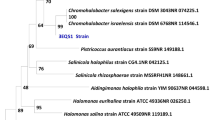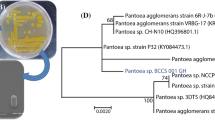Abstract
Recently, the production of exopolysaccharide from Pseudozyma sp. SY16, which is mannosylerythritol lipid-producing yeast, has been occasionally observed during industrial fermentations. Moreover, exopolysaccharides derived from microbes are in high demand for the production of biopolymers. Therefore, this study aimed to investigate the production and characteristics of the exopolysaccharide produced by this strain. In batch fermentations with this strain, the maximum production yield of exopolysaccharide (5.8 g/L) was obtained under olive oil supplementation as a carbon source with culture conditions of 30°C, pH 8.0, and 600 rpm. Through a series of liquid chromatography steps, the exopolysaccharide was successfully purified, and its emulsifying activity was demonstrated. In addition, two-dimensional nuclear magnetic resonance analysis revealed that the exopolysaccharide is a galactoglucomannan with a novel and unique structure, consisting of galactose, glucose, and mannose in the ratio of 1:5:3.
Similar content being viewed by others
References
Kim, H. S., B. D. Yoon, D. H. Choung, H. M. Oh, T. Katsuragi, and Y. Tani (1999) Characterization of a biosurfactant, mannosylerythritol lipid produced from Candida sp. SY16. Appl. Microbiol. Biotechnol. 52: 713–721.
Iyer, A., K. Mody, and B. Jha (2006) Emulsifying properties of a marine bacterial exopolysaccharide. Enzyme Microb. Technol. 38: 220–222.
More, T. T., J. S. S. Yadav, S. Yan, R. D. Tyagi, and R. Y. Surampalli (2014) Extracellular polymeric substances of bacteria and their potential environmental applications. J. Environ. Manage. 144: 1–25.
Neu, T. R., T. Dengler, B. Jann, and K. Poralla (1992) Structural studies of an emulsion-stabilizing exopolysaccharide produced by an adhesive, hydrophobic Rhodococcus strain. J. Gen. Microbiol. 138: 2531–2537.
Vijayendra, S. V. N. and T. R. Shamala (2014) Film forming microbial biopolymers for commercial applications-a review. Crit. Rev. Biotechnol. 34: 338–357.
Duboc, P. and B. Mollet (2001) Applications of exopolysaccharides in the dairy industry. Int Dairy J. 11: 759–768.
Lawford, H. G. and J. D. Rousseau (1991) Bioreactor design considerations in the production of high-quality microbial exopolysaccharide. Appl. Biochem. Biotechnol. 28: 667–684.
Seviour, R. J., B. McNeil, M. L. Fazenda, and L. M. Harvey (2011) Operating bioreactors for microbial exopolysaccharide production. Crit. Rev. Biotechnol. 31: 170–185.
Scheller, H. V. and P. Ulvskov (2010) Hemicelluloses. Annu. Rev. Plant. Biol. 61: 263–289.
Willför, S., K. Sundberg, M. Tenkanen, and B. Holmbom (2008) Spruce-derived mannans — A potential raw material for hydrocolloids and novel advanced natural materials. Carbohydr. Polym. 72: 197–210.
Price, N. P. J., T. M. Hartman, T. A. Faber, K. E. Vermillion, and G. C. Fahey (2011) Galactoglucomannan oligosaccharides (GGMO) from a molasses byproduct of pine (Pinus taeda) fiberboard production. J. Agric. Food Chem. 59: 1854–1861.
Kielak, A. M., T. C. L. Castellane, J. C. Campanharo, L. A. Colnago, O. Y. A. Costa, M. L. Corradi da Silva, J. A. van Veen, E. G. M. Lemos, and E. E. Kuramae (2017) Characterization of novel Acidobacteria exopolysaccharides with potential industrial and ecological applications. Sci. Rep. 7: 41193.
Kuncheva, M., K. Pavlova, I. Panchev, and S. Dobreva (2007) Emulsifying power of mannan and glucomannan produced by yeasts. Int. J. Cosmet. Sci. 29: 377–384.
Kim, H. S., C. H. O. Lee, H. H. Suh, K. H. Ahn, H. M. Oh, G. Kwon, J. I. W. Yang, and B. D. Yoon (1997) A lipopeptide biosurfactant produced by Bacillus subtilis C9 selected through the oil film-collapsing assay. J. Microbiol. Biotechnol. 7: 180–188.
Sugita, T., M. Takashima, N. Poonwan, N. Mekha, K. Malaithao, B. Thungmuthasawat, S. Prasarn, P. Luangsook, and T. Kudo (2003) The first isolation of ustilaginomycetous anamorphic yeasts, Pseudozyma species, from patients’ blood and a description of two new species: P. parantarctica and P. thailandica. Microbiol. Immunol. 47: 183–190.
Kim, H. S., J. W. Jeon, B. H. Kim, C. Y. Ahn, H. M. Oh, and B. D. Yoon (2006) Extracellular production of a glycolipid biosurfactant, mannosylerythritol lipid, by Candida sp. SY16 using fed-batch fermentation. Appl. Microbiol. Biotechnol. 70: 391–396.
Kim, H. S., J. W. Jeon, H. W. Lee, Y. I. Park, W. T. Seo, H. M. Oh, T. Katsuragi, Y. Tani, and B. D. Yoon (2002) Extracellular production of a glycolipid biosurfactant, mannosylerythritol lipid, from Candida antarctica. Biotechnol. Lett. 24: 225–229.
Kim, B. H., R. Ramanan, D. H. Cho, H. M. Oh, and H. S. Kim (2014) Role of Rhizobium, a plant growth promoting bacterium, in enhancing algal biomass through mutualistic interaction. Biomass Bioenergy. 69: 95–105.
Badr-Eldin, S. M., O. M. El-Tayeb, H. G. El-Masry, F. H. A. Mohamad, and O. A. A. El-Rahman (1994) Polysaccharide production by Aureobasidium pullulans: factors affecting polysaccharide formation. World J. Microbiol. Biotechnol. 10: 423–426.
Cho, D. H., R. Ramanan, J. Heo, J. Lee, B. H. Kim, H. M. Oh, and H. S. Kim (2015) Enhancing microalgal biomass productivity by engineering a microalgal-bacterial community. Bioresour. Technol. 175: 578–585.
Ghadge, S. V. and H. Raheman (2005) Biodiesel production from mahua (Madhuca indica) oil having high free fatty acids. Biomass Bioenergy. 28: 601–605.
Ahn, S. G., H. H. Suh, C. H. Lee, S. H. Moon, H. S. Kim, K. H. Ahn, G. S. Kwon, H. M. Oh, and B. D. Yoon (1998) Isolation and characterization of a novel polysaccharide producing Bacillus polymyxa A49 KCTC 4648P. J. Microbiol. Biotechnol. 8: 171–177.
Cataldi, T. R. I., C. Campa, and G. E. De Benedetto (2000) Carbohydrate analysis by high-performance anion-exchange chromatography with pulsed amperometric detection: the potential is still growing. Fresenius J. Anal. Chem. 368: 739–758.
Hall, K. B. (1994) Interaction of RNA hairpins with the human U1A N-terminal RNA binding domain. Biochemistry. 33: 10076–10088.
Gerson, D. F., M. M. Kole, B. Ozum, and M. N. Oguztoreli (1988) Substrate concentration control in bioreactors. Biotechnol. Genet. Eng. Rev. 6: 67–150.
Willför, S., R. Sjöholm, C. Laine, M. Roslund, J. Hemming, and B. Holmbom (2003) Characterisation of water-soluble galactoglucomannans from Norway spruce wood and thermomechanical pulp. Carbohydr. Polym. 52: 175–187.
Mikkonen, K. S., M. Tenkanen, P. Cooke, C. Xu, H. Rita, S. Willför, B. Holmbom, K. B. Hicks, and M. P. Yadav (2009) Mannans as stabilizers of oil-in-water beverage emulsions. Lebenson Wiss Technol. 42: 849–855.
Lundqvist, J., A. Jacobs, M. Palm, G. Zacchi, O. Dahlman, and H. Stålbrand (2003) Characterization of galactoglucomannan extracted from spruce (Picea abies) by heat-fractionation at different conditions. Carbohydr. Polym. 51: 203–211.
Lundqvist, J., A. Teleman, L. Junel, G. Zacchi, O. Dahlman, F. Tjerneld, and H. Stålbrand (2002) Isolation and characterization of galactoglucomannan from spruce (Picea abies). Carbohydr. Polym. 48: 29–39.
Polari, L., P. Ojansivu, S. Makela, C. Eckerman, B. Holmbom, and S. Salminen (2012) Galactoglucomannan extracted from spruce (Picea abies) as a carbohydrate source for probiotic bacteria. J. Agric. Food Chem. 60: 11037–11043.
Acknowledgements
This research was supported by the KRIBB (Korea Research Institute of Bioscience and Biotechnology) Research Initiative Program (Grant No. KGS1292012; KGM5252012)(http://www.kribb.re.kr).
The authors declare no conflict of interest.
Neither ethical approval nor informed consent was required for this study.
Author information
Authors and Affiliations
Corresponding author
Additional information
Publisher’s Note
Springer Nature remains neutral with regard to jurisdictional claims in published maps and institutional affiliations.
Electronic supplementary material
Rights and permissions
About this article
Cite this article
Kim, K.N., Lee, Y.J., Cho, DH. et al. A Novel Galactoglucomannan Exopolysaccharide Produced by Oil Fermentation with Pseudozyma sp. SY16. Biotechnol Bioproc E 25, 742–748 (2020). https://doi.org/10.1007/s12257-020-0066-x
Received:
Revised:
Accepted:
Published:
Issue Date:
DOI: https://doi.org/10.1007/s12257-020-0066-x




